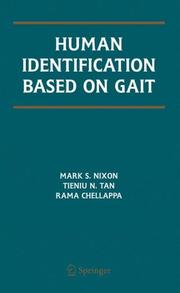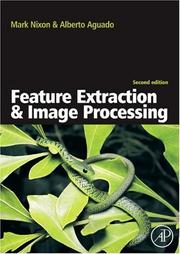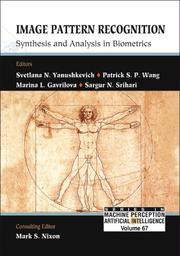| Listing 1 - 10 of 17 | << page >> |
Sort by
|

ISBN: 0750650788 9786611022013 1281022012 0080506259 9780080506258 9780750650786 9781281022011 Year: 2002 Publisher: Oxford Newnes
Abstract | Keywords | Export | Availability | Bookmark
 Loading...
Loading...Choose an application
- Reference Manager
- EndNote
- RefWorks (Direct export to RefWorks)
Focusing on feature extraction while also covering issues and techniques such as image acquisition, sampling theory, point operations and low-level feature extraction, the authors have a clear and coherent approach that will appeal to a wide range of students and professionals.*Ideal module text for courses in artificial intelligence, image processing and computer vision*Essential reading for engineers and academics working in this cutting-edge field*Supported by free software on a companion website
beeldverwerking --- Artificial intelligence. Robotics. Simulation. Graphics --- visuele analyse --- grafische toepassingen (informatica) --- beelddigitalisering --- Image processing. --- Traitement d'images. --- Computer vision. --- Digital techniques. --- Image processing. Traitement d’images. --- Mathematics. --- Pattern recognition systems. --- Image processing --- Engineering & Applied Sciences --- Applied Physics --- Computer Science --- Pictorial data processing --- Picture processing --- Processing, Image --- Imaging systems --- Optical data processing --- Image processing. Traitement d'images. --- Optical data processing.

ISBN: 9780387294889 0387244247 9780387244242 9786612823398 0387294880 1282823396 Year: 2006 Publisher: New York : Springer,
Abstract | Keywords | Export | Availability | Bookmark
 Loading...
Loading...Choose an application
- Reference Manager
- EndNote
- RefWorks (Direct export to RefWorks)
Biometrics now affect many people's lives, and is the focus of much academic research and commercial development. Gait is one of the most recent biometrics, with its own unique advantages. Gait recognizes people by the way they walk and run, analyzes movement,which in turn implies analyzing sequences of images. This professional book introduces developments from the laboratories of very distinguished researchers within this relatively new area of biometrics and clearly establishes human gait as a biometric. Human Identification Based on Gait provides a snapshot of all the biometric work in human identification by gait (all major centers for research are indicated in this book). To complete the picture, studies are included from medicine, psychology and other areas wherein we find not only justification for the use of gait as a biometric, but also pointers to techniques and to analysis. Human Identification Based on Gait is designed for a professional audience, composed of researchers and practitioners in industry. This book is also suitable as a secondary text for graduate-level students in computer science. .
Computer Science. --- Pattern Recognition. --- Image Processing and Computer Vision. --- Computer Imaging, Vision, Pattern Recognition and Graphics. --- Multimedia Information Systems. --- Biometrics. --- Data Structures, Cryptology and Information Theory. --- Computer science. --- Data structures (Computer science). --- Multimedia systems. --- Computer vision. --- Optical pattern recognition. --- Informatique --- Structures de données (Informatique) --- Multimédia --- Vision par ordinateur --- Reconnaissance optique des formes (Informatique) --- Biometric identification. --- Gait in humans. --- Biometric identification --- Gait in humans --- Biometry --- Gait --- Epidemiologic Measurements --- Movement --- Physical Examination --- Statistics as Topic --- Epidemiologic Methods --- Diagnostic Techniques and Procedures --- Public Health --- Musculoskeletal Physiological Processes --- Diagnosis --- Musculoskeletal Physiological Phenomena --- Environment and Public Health --- Investigative Techniques --- Health Care --- Analytical, Diagnostic and Therapeutic Techniques and Equipment --- Musculoskeletal and Neural Physiological Phenomena --- Phenomena and Processes --- Electrical Engineering --- Computer Science --- Electrical & Computer Engineering --- Engineering & Applied Sciences --- Human gaits --- Biometric person authentication --- Biometrics (Identification) --- Multimedia information systems. --- Computer graphics. --- Image processing. --- Pattern recognition. --- Biometrics (Biology). --- Human locomotion --- Running --- Walking --- Anthropometry --- Identification --- Data structures (Computer scienc. --- Data Structures and Information Theory. --- Data structures (Computer science) --- Computer-based multimedia information systems --- Multimedia computing --- Multimedia information systems --- Multimedia knowledge systems --- Information storage and retrieval systems --- Machine vision --- Vision, Computer --- Artificial intelligence --- Image processing --- Pattern recognition systems --- Optical data processing --- Pattern perception --- Perceptrons --- Visual discrimination --- Information structures (Computer science) --- Structures, Data (Computer science) --- Structures, Information (Computer science) --- Electronic data processing --- File organization (Computer science) --- Abstract data types (Computer science) --- Optical data processing. --- Design perception --- Pattern recognition --- Form perception --- Perception --- Figure-ground perception --- Optical computing --- Visual data processing --- Bionics --- Integrated optics --- Photonics --- Computers --- Biological statistics --- Biology --- Biometrics (Biology) --- Biostatistics --- Biomathematics --- Statistics --- Optical equipment --- Statistical methods --- Identification biométrique. --- Marche (locomotion)
Book
ISBN: 0123965497 0123978246 9780123978240 9780123965493 Year: 2012 Publisher: Oxford : Academic,
Abstract | Keywords | Export | Availability | Bookmark
 Loading...
Loading...Choose an application
- Reference Manager
- EndNote
- RefWorks (Direct export to RefWorks)
This book is an essential guide to the implementation of image processing and computer vision techniques, with tutorial introductions and sample code in Matlab. Algorithms are presented and fully explained to enable complete understanding of the methods and techniques demonstrated. As one reviewer noted, ""The main strength of the proposed book is the exemplar code of the algorithms."" Fully updated with the latest developments in feature extraction, including expanded tutorials and new techniques, this new edition contains extensive new material on Haar wavelets, Viola-Jones, bilateral fi
Computers, Optical. --- Pattern perception. --- Computer vision. --- Computer vision --- Pattern recognition systems. --- Image processing --- Mathematics. --- Digital techniques. --- Digital image processing --- Digital electronics --- Pattern classification systems --- Pattern recognition computers --- Pattern perception --- Machine vision --- Vision, Computer --- Artificial intelligence --- Pattern recognition systems
Book
ISBN: 0128149760 0128149779 9780128149775 9780128149768 Year: 2020 Publisher: [Place of publication not identified] Academic Press
Abstract | Keywords | Export | Availability | Bookmark
 Loading...
Loading...Choose an application
- Reference Manager
- EndNote
- RefWorks (Direct export to RefWorks)
Computer vision. --- Machine vision --- Vision, Computer --- Artificial intelligence --- Image processing --- Pattern recognition systems --- Digital techniques. --- Digital image processing --- Digital electronics

ISBN: 9780123725387 0123725380 Year: 2008 Publisher: London: Elsevier,
Abstract | Keywords | Export | Availability | Bookmark
 Loading...
Loading...Choose an application
- Reference Manager
- EndNote
- RefWorks (Direct export to RefWorks)
Multi
ISBN: 9780128149775 0128149779 0128149760 9780128149768 Year: 2020 Publisher: London, England : Academic Press,
Abstract | Keywords | Export | Availability | Bookmark
 Loading...
Loading...Choose an application
- Reference Manager
- EndNote
- RefWorks (Direct export to RefWorks)
"Feature Extraction for Image Processing and Computer Vision is an essential guide to the implementation of image processing and computer vision techniques, with tutorial introductions and sample code in MATLAB and Python. Algorithms are presented and fully explained to enable complete understanding of the methods and techniques demonstrated. As one reviewer noted, ""The main strength of the proposed book is the link between theory and exemplar code of the algorithms."" Essential background theory is carefully explained. This text gives students and researchers in image processing and computer vision a complete introduction to classic and state-of-the art methods in feature extraction together with practical guidance on their implementation. The only text to concentrate on feature extraction with working implementation and worked through mathematical derivations and algorithmic methods A thorough overview of available feature extraction methods including essential background theory, shape methods, texture and deep learning Up to date coverage of interest point detection, feature extraction and description and image representation (including frequency domain and colour) Good balance between providing a mathematical background and practical implementation Detailed and explanatory of algorithms in MATLAB and Python".
Computer vision. --- Image processing --- Digital techniques. --- Computer vision --- Pattern recognition systems. --- Mathematics.
Digital
ISBN: 9780123978240 0123978246 Year: 2012 Publisher: Oxford Academic Press
Abstract | Keywords | Export | Availability | Bookmark
 Loading...
Loading...Choose an application
- Reference Manager
- EndNote
- RefWorks (Direct export to RefWorks)
This book is an essential guide to the implementation of image processing and computer vision techniques, with tutorial introductions and sample code in Matlab. Algorithms are presented and fully explained to enable complete understanding of the methods and techniques demonstrated. As one reviewer noted, "The main strength of the proposed book is the exemplar code of the algorithms." Fully updated with the latest developments in feature extraction, including expanded tutorials and new techniques, this new edition contains extensive new material on Haar wavelets, Viola-Jones, bilateral filtering, SURF, PCA-SIFT, moving object detection and tracking, development of symmetry operators, LBP texture analysis, Adaboost, and a new appendix on color models. Coverage of distance measures, feature detectors, wavelets, level sets and texture tutorials has been extended.
Book
ISBN: 9781441937421 1441937420 Year: 2011 Publisher: New York ; London : Springer,
Abstract | Keywords | Export | Availability | Bookmark
 Loading...
Loading...Choose an application
- Reference Manager
- EndNote
- RefWorks (Direct export to RefWorks)
Biometric identification. --- Gait in humans. --- Identification biométrique --- Démarche chez l'homme

ISBN: 1281120952 9786611120955 9812770674 9789812770677 9789812569080 9812569081 9789812770677 Year: 2007 Publisher: Singapore World Scientific
Abstract | Keywords | Export | Availability | Bookmark
 Loading...
Loading...Choose an application
- Reference Manager
- EndNote
- RefWorks (Direct export to RefWorks)
The field of biometrics utilizes computer models of the physical and behavioral characteristics of human beings with a view to reliable personal identification. The human characteristics of interest include visual images, speech, and indeed anything which might help to uniquely identify the individual. The other side of the biometrics coin is biometric synthesis - rendering biometric phenomena from their corresponding computer models. For example, we could generate a synthetic face from its corresponding computer model. Such a model could include muscular dynamics to model the full gamut of
Pattern recognition systems --- Biometric identification --- Identification --- Artificial intelligence --- Mathematical models --- Automation
Book
ISBN: 1447165241 1447165233 Year: 2014 Publisher: London : Springer London : Imprint: Springer,
Abstract | Keywords | Export | Availability | Bookmark
 Loading...
Loading...Choose an application
- Reference Manager
- EndNote
- RefWorks (Direct export to RefWorks)
As the plethora of approaches to biometrics and their deployment continues to grow, so too does the need to combat the techniques used to subvert the aim of such biometric systems. Presenting the first definitive study of the subject, this Handbook of Biometric Anti-Spoofing reviews the state of the art in covert attacks against biometric systems, and in deriving countermeasures to these attacks. Across a range of common biometrics, including face, iris, fingerprint, speaker and gait, the book describes spoofing methods and examines the vulnerabilities of biometric systems to these attacks. Novel theoretical methods are also introduced to evaluate the various possible countermeasures. Topics and features: Provides a detailed introduction to the field of biometric anti-spoofing and a thorough review of the associated literature Examines spoofing attacks against five biometric modalities, namely, fingerprints, face, iris, speaker and gait Discusses anti-spoofing measures for multi-model biometric systems Reviews evaluation methodologies, international standards, and legal and ethical issues Describes current challenges and suggests directions for future research Presents the latest work from a global selection of experts in the field, including members of the TABULA RASA project This comprehensive text/reference is truly essential reading for all biometric researchers and practitioners in industry and academia. Graduate students of computer science and electronic engineering will also find the book to be a useful supplementary reference for courses on biometrics.
Biometric identification --- Impersonation --- Acting --- Comedy --- Imitation --- Biometric person authentication --- Biometrics (Identification) --- Anthropometry --- Identification --- Computer system performance. --- Computer vision. --- Optical pattern recognition. --- Computer science. --- System Performance and Evaluation. --- Image Processing and Computer Vision. --- Pattern Recognition. --- Probability and Statistics in Computer Science. --- Informatics --- Science --- Optical data processing --- Pattern perception --- Perceptrons --- Visual discrimination --- Machine vision --- Vision, Computer --- Artificial intelligence --- Image processing --- Pattern recognition systems --- Computer system failures. --- Optical data processing. --- Pattern recognition. --- Mathematical statistics. --- Mathematics --- Statistical inference --- Statistics, Mathematical --- Statistics --- Probabilities --- Sampling (Statistics) --- Design perception --- Pattern recognition --- Form perception --- Perception --- Figure-ground perception --- Optical computing --- Visual data processing --- Bionics --- Electronic data processing --- Integrated optics --- Photonics --- Computers --- Computer failures --- Computer malfunctions --- Computer systems --- Failure of computer systems --- System failures (Engineering) --- Fault-tolerant computing --- Statistical methods --- Optical equipment --- Failures
| Listing 1 - 10 of 17 | << page >> |
Sort by
|

 Search
Search Feedback
Feedback About UniCat
About UniCat  Help
Help News
News